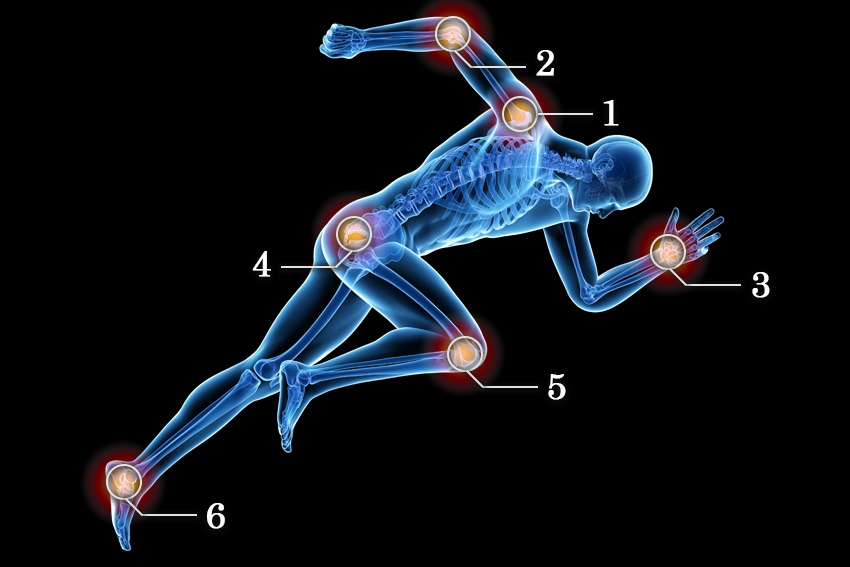
1. Shoulder Injuries
Rotator Cuff Tendinitis: a condition which involves swelling of the rotator cuff. The rotator cuff includes the muscles that hold your arm in the shoulder joint. The rotator cuff includes four muscles that elevate and rotate your shoulder joint. Often referred to as swimmer’s or pitcher’s shoulder or impingement syndrome. Results from repetitive overhead motion. Symptoms: Shoulder pain and tightness
Shoulder Instability: This condition can be classified into 2 groups…
Dislocation: The Humeral head completely “pops out” of the shoulder socket. Usually a result of direct trauma to the shoulder joint or a fall with an outstretched arm.
Subluxation: This condition usually results from ligament laxity or poor strength in the rotator cuff. The shoulder feels like it “pops out” and then pops right back in place. Usually non-traumatic Often occurs in young athletes.
Bicipital Tendonitis: a condition that presents with pain in the front of the shoulder and arm leading down to your elbow. Your biceps muscle helps lifts your arm overhead and the biceps tendon can get irritated as it passes through the bicipital groove. This injury is very common in overhead throwing athletes.
2 . Elbow Injuries
Medial Epicondylitis – Often referred to as “golfers elbow”. This condition presents as pain in the inner elbow region. Any activities that stress the forearm muscles can lead to this problem. Pain worsens with wrist flexion and pronation activities. Discomfort can occur when simply shaking hands with someone. History of an acute injury may be reported (eg, taking a divot in golf, throwing a pitch in baseball, a hard serve in tennis). Occasional or constant numbness and/or tingling sensation that radiates into their fourth and fifth fingers, suggesting involvement of the ulnar nerve.
Lateral Epicondylitis- Often referred to as “tennis elbow”. This condition presents as pain in the outer elbow and down the forearm. The muscles that lift your hand up insert on the lateral elbow (lateral epicondyle). Lateral epicondylitis is common in people who spend a lot of time on computers, repetitive gripping and in people with jobs that include carpentry and painting.
3. Wrist Injuries
Carpal Tunnel Syndrome – This condition occurs when the median nerve becomes compressed in the wrist. Often seen in the working population with people who work on the computer using a keyboard repetitively. The wrist canal where most of your tendons and blood vessels cross is too tight. Common symptoms include numbness and tingling in your thumb and index finger. Night pain, temperature sensitivity, forearm pain.
DeQuervain's Tendinitis– Irritation or swelling of the tendons along the thumb side of the wrist. This pain can extend up the wrist into the forearm. Signs/Symptoms-Pain with increased use of the hand and/or wrist. In particular, with gripping activities. “Catching” or “Snapping” of the thumb with movement.
4. Hip Injuries
Trochanteric Bursitis - Inflammation of bursa (fat pad) that lies between the greater trochanter (outer knob of the thigh bone), and the iliotibial band (a strong sheet of fascia that provides a protective layering over the thigh muscles). Symptoms– Pain overlying the hip. Pain increases while sleeping on the affected side or with walking. May cause radiating pain down to outer thigh.
FAI (Femoroacetabular Impingement): This condition involves one or more anatomical abnormalities of the hip joint. It occurs when the hip joint which is a ball and socket joint is abnormally shaped. It presents with pain in the groin, buttock, front of the hip and lateral hip.
5. Knee Injuries
Patellar Tendinitis : Often referred to as “Jumper's Knee”. This condition results from overuse of the knee. This overuse injury results in microtears of the patellar tendon leading to pain and swelling. The patellar tendon attaches the quadriceps muscle to the tibia (shin bone). This injury often occurs in people who do a great deal of running, jumping, stopping and starting.
Iliotibial Band Syndrome : Known as the pain you CANNOT run through. ITBS is a condition characterized by pain on the lateral side of the knee over the lateral femoral epicondyle. The ITB runs from the hip down to the lateral knee. The pain usually begins in the middle or at the end of the run. Pain usually increases with downhill running and any loaded knee flexion activities. Causes: ITB tightness, overtraining, faulty biomechanics, decreased hip strength, tight calf muscles. Treatments: Physical Therapy, Rest, Ice, NSAIDs, Stretching, Custom Orthotics.
Patellofemoral Syndrome (PFS): This condition is common in the adolescent population. Commonly called “Runner’s Knee”. The pain presents in front of the knee with descending stairs, running and lunging/squatting. Most commonly due to weakness in the quad muscle (thigh), poor biomechanics, incorrect footwear and/or tightness in the ITB.
6. Foot/Ankle Injuries
Plantar Fasciitis – Often referred to as a “heel” spur. This condition presents as pain in the heel and arch of your foot. Most people feel this pain during their first few steps in the morning or after sustained standing. This condition requires adequate stretching of the calf and plantar fascia as well as deep tissue massage, drying needling, shockwave therapy and graston. A 4D motion/gait analysis is also recommended to determine if you are in in the correct shoes.
Achilles Tendinitis – Inflammation of the large tendon in the back of the ankle. It is an overuse injury that can lead to pain and swelling. Running or walking up or down hills can aggravate this condition. Ignoring this condition can lead to constant pain with weight-bearing activities and or rupturing the tendon.
